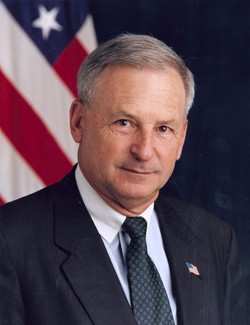Cites Tenerife Accident Before AAAE Conference
 On Monday, National
Transportation Safety Board Chairman Mark V. Rosenker told a
gathering of airport executives that prompt action is needed to
prevent potentially catastrophic accidents on the nation's
runways.
On Monday, National
Transportation Safety Board Chairman Mark V. Rosenker told a
gathering of airport executives that prompt action is needed to
prevent potentially catastrophic accidents on the nation's
runways.
Speaking at a conference on new developments in airport
technology -- jointly hosted by the American Association of Airport
Executives and the FAA in Atlantic City, NJ -- Rosenker noted that
the worst accident in aviation history was a runway collision that
cost 583 lives on the island of Tenerife... and that the number of
serious runway incursions continues to climb.
Rosenker repeated his earlier comments regarding several recent
near-collisions that were avoided only "through flight
crew actions sometimes bordering on the heroic -- along with a lot
of luck. That is not good enough," he said.
Rosenker stated that airport surface operations present some of
the most challenging situations for pilots and controllers, and in
many cases leave the least room for error. The potential for
traffic conflicts, he said, are exacerbated by the numbers of
ground support vehicles, including maintenance vehicles, baggage
carts, catering trucks, fuel tankers, snow plows and other ground
traffic vying for space on a busy airport.
"In the air," said Rosenker, "we try to maintain miles of space
between aircraft. But on the tarmac, taxiways and runways, the
tolerances are comparatively small; the difference between being in
a safe place and an unsafe place is measured in feet, not
miles."
Rosenker said that the hazards of airport surface operations
have been a concern of the Safety Board for many years, noting that
the runway incursion issue has been on the Board's Most Wanted List
of safety improvements since its inception in 1990. Board
recommendations related to runway incursions have addressed
improvements in air traffic control operations, training and
hardware, pilot training, airport signage, lighting and markings,
aircraft visibility, and incident reporting.
To ensure that all commercial passengers are effectively
protected against the dangers of runway incursions, Rosenker said,
the Board has urged FAA to develop and demonstrate ground movement
safety systems appropriate for use at airports ranging from large
international facilities to the smaller regional fields served only
by commuter airlines.
He said the Board did not expect the answer to be a one-
size-fits-all system but would instead "require creative use of
different combinations of sensors, processors, and warning methods
tailored to the requirements of each situation."
Rosenker acknowledged that delivering effective technological
solutions takes time but noted that there are some technologies
already available that could help prevent runway incursions. The
dangers of incursions are here now, he said, and "the continuing
occurrence of hazardous incidents show that we still have work to
do."
 ANN's Daily Aero-Linx (05.02.24)
ANN's Daily Aero-Linx (05.02.24) ANN's Daily Aero-Term (05.02.24): Touchdown Zone Lighting
ANN's Daily Aero-Term (05.02.24): Touchdown Zone Lighting Aero-News: Quote of the Day (05.02.24)
Aero-News: Quote of the Day (05.02.24) ANN FAQ: Contributing To Aero-TV
ANN FAQ: Contributing To Aero-TV NTSB Final Report: Cirrus Design Corp SR20
NTSB Final Report: Cirrus Design Corp SR20



